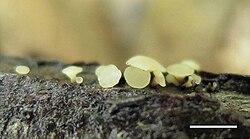| Chlorovibrissea | |
|---|---|
 | |
| Chlorovibrissea korfii in Yunnan province, China | |
| Scientific classification | |
| Kingdom: | |
| Division: | |
| Class: | |
| Order: | |
| Family: | |
| Genus: | Chlorovibrissea L.M.Kohn (1989) |
| Type species | |
| Chlorovibrissea bicolor (G.W.Beaton & Weste) L.M.Kohn (1989) | |
| Species | |
C. bicolor | |
Chlorovibrissea is a genus of six or more aquatic or semi-aquatic fungi in the family Vibrisseaceae. [1] [2] Most species are found in Australasia [3] but C. chilensis, described as new to science in 2014, is from South America [4] and C. korfii is from China. [2]